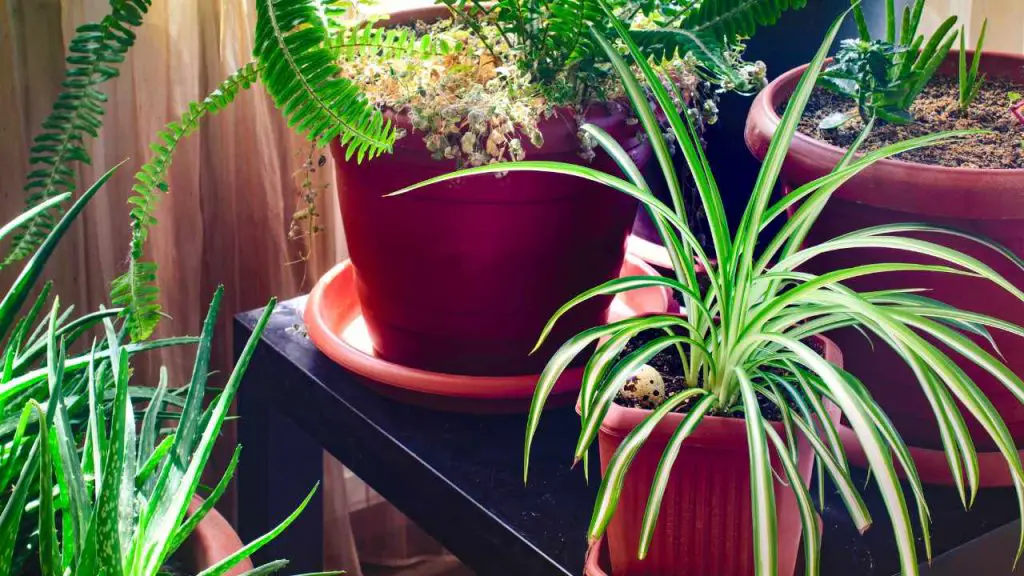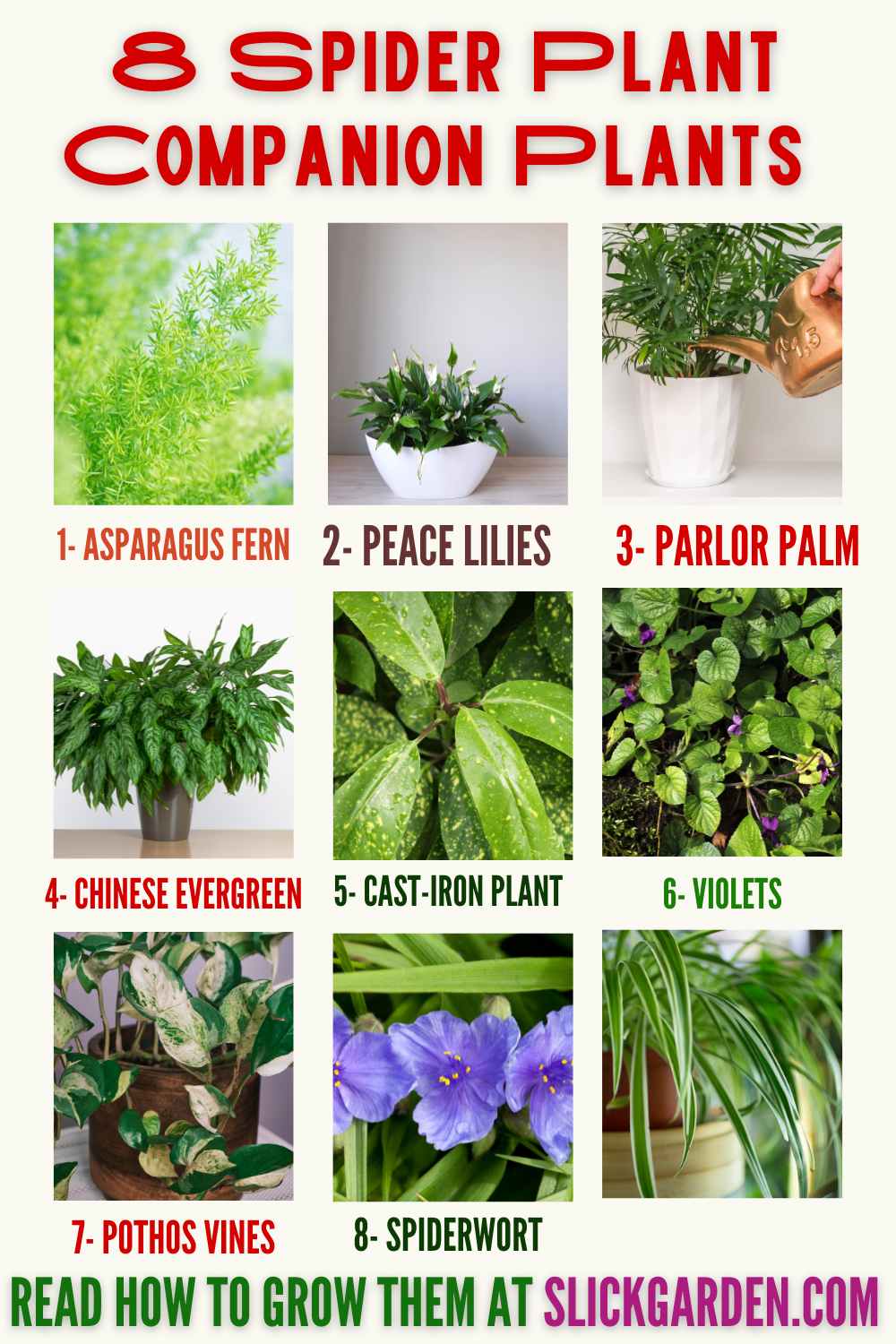We try our best to make our plants happy and healthy. But sometimes it happens that some plants are not comfortable with each other, in other words, they don’t like each other.
For instance, if you grow tomato plants with bean plants then beans will not get proper sunlight due to the shade of taller tomato plants. This is a serious matter and you have to think about that.

Gardening is not so easy, you have to study very critically the nature of plants. You have to understand the needs of your plants.
It indicates that we should make groups of plants that have similar living requirements. Some plants like sunlight while others prefer shade. Before planting different plants you should check their compatibility.
Companion Plants For Spider Plant
If you want to know which companion plants are perfect for a spider plant then you are reading the light article. Spider plants like warm tropical environments and can’t survive in frost.
As a houseplant, we must understand the needs and requirements of spider plants. Then we can choose the plants that prefer to grow with spider plants.
Benefits Of Growing Spider Plants With Companion Plants
Spider plants are ideal for growing indoors. If you choose the right companion plants then spider plants offer more benefits. Companion gardening is a best practice because it has many advantages. Following are some benefits that you should read.
1- IMPROVED AIR QUALITY
When you grow spider plants indoors with other companion plants they help to purify the indoor environment and you can breathe in the fresh air. Spider plants with fellow plants perform the function of the natural purifier and improve air quality.
2- INCREASE PESTS AND DISEASE RESISTANCE
When you grow spider cars with different companion flowers it will help to reduce the risk of different harmful pests and fungal diseases.
This practice of planting plays an important role in the health of your plants. For a perfect garden, you must prefer companion gardening to protect your plants from unwanted insects and pests.
3- IMPROVED AESTHETICS
You should select companion plants for the Spider plant that create a beautiful display. The pair of colorful houseplants bring a positive effect to your indoor environment.
The combination of attractive plants also shows your aesthetic sense and creativity. You must arrange them in such a way so they look fabulous with each other.
Choosing The Right Companion Plants For Spider Plants

Choosing the right companion for a spider plant is a challenging task. The needs of spider plants are right indirect light and moist soil.
So you should select those plants whose requirements are the same. Following is a list of plants that are a perfect match for spider plants.
1- ASPARAGUS FERN
The first plant that is included in our list is asparagus as it also prefers indirect light. If you are growing asparagus fern outdoors then you must select a partially shaded area.
Make sure the soil you are using must be well-drained, moist, and rich. You can also grow it as a houseplant because it can tolerate low light.
You have to maintain the moisture level of the soil by regular watering. if you are not saying that as per against funds are turning brown and droopy it means it needs more water.
Regular inspection of the soil is very important. If you feel the top Inch of the soil is dry then water the plant without wasting the time. On summer days, asparagus ferns need more water which will help to prevent the soil from drying.
The suitable temperature for growing asparagus is between 55 to 70 degrees Fahrenheit. Sudden changes in the temperature are not good.
It is better to use diluted fertilizer for feeding the asparagus fern. If you are growing your plant in a container or pot then you must feed it monthly.
2- PEACE LILIES
Peace lilies are aromatic tropical plants and can be grown as houseplants. Dark green foliage with signature white blooms looks very elegant in your indoor area.
The shape of the flowers is very unique. The fragrant flowers of peace lilies have only one large white petal. The shape of the petal is just like an upright leaf.
Like spider plants please please also like in partially shady areas if you grow them outdoors. Low-lighted areas are perfect for growing them because they receive moderate and indirect sunlight.
Plants need water on time, when you see the leaves of a peace lily begin to droop, it means it needs water. When you water it then it will return to its upright state.
If you see black tips on the leaves then this is a clear sign your plant is receiving less water. So you have to increase the frequency of water to keep it healthy.
3- PARLOR PALM
This is another popular houseplant that is a perfect companion to the spider plant. This plant has light green fronds and needs little maintenance. Just like the spider plant parlor palm also helps to purify indoor air.
Rich soil, indirect bright light, regular water, and feeding are the growing requirements of parlor palms. You should fulfill all the essential requirements of the plant to keep it looking good.
Direct sunlight can damage this plant and it needs less water in winter. Liquid fertilizer is best for feeding this plant in the spring and summer.
If you are growing parlor palm in a pot or container then make sure it has drainage holes at the bottom. Fill your pot or container with a high-quality potting mix.
When you see the plant is overgrown then you can transfer it into a larger pot or container. The best time of repotting the plant is in spring.
4- CHINESE EVERGREEN
The exotic-looking foliage makes the Chinese evergreen an adorable plant. If you are a beginner and don’t know anything about gardening then you must select this plant because it needs little maintenance and you can easily handle it.
The ideal temperature for the growth of a Chinese evergreen plant is between 65 to 80 degrees Fahrenheit. This plant can’t survive below 60 degrees Fahrenheit. The suitable humidity level is 60 to 70%. You can also use a humidifier if you are growing a Chinese evergreen plant indoors.
You can buy a young plant from any gardening store or local nursery and transplant it into the desired pot. Make sure the pot must be 1 to 2 inches wider than the root ball of your Chinese evergreen plant.
5- CAST-IRON PLANT
The cast-iron plant has attractive glossy green, long, tapered leaves with stripes or spots. This plant produces strange-looking purple flowers but if you are growing it indoors then it will not produce flowers. Without thinking too much you can select this plant as a companion for the spider plant.
The interesting thing about this evergreen perennial plant is that you can even place it in a dark place and water it less often. This can be an incredible houseplant.
Never place the cast iron plant in direct sunlight because the heat of the sun can burn captivating leaves. You should avoid over-watering because it can turn the tips of the leaves brown.
You should not compromise on the soil and make sure it is full of nutrients so your plant will thrive well. The soil must contain coconut coir and compost. This will help to retain water and provide all the essential nutrients.
6- VIOLETS
You should select violets because of their perfumed flowers. These flowers will add fragrance to your garden. They like to grow in rich fertile soil in a shady place.
To improve the quality of the soil you can add compost and manure. You can use a slow-release fertilizer to feed this plant in spring and late summer to encourage continuous blooms.
You can easily propagate this plant from seeds or cuttings. There are 500 + species of violets found in the world. The famous violet varieties are Common Blue Violet, Johnny-Jump-Up, and Sweet Violet.
Violets like to grow in a cold environment; they can’t tolerate warm weather. To encourage new growth you must deadhead the flowers. If the plant is overgrown then you can transfer it to a larger pot to encourage the production of more flowers.
7- POTHOS VINES
Pothos and spider plants’ requirements are similar. It means they can be the best-neighboring plants because you have to maintain the same temperature and humidity level for them.
Both can adjust in low light and hate overwatering. They create a striking effect when they grow as companions of each other.
The popular pothos cultivars are Pearl and jade pothos, Neon Pothos, Marble Queen Pothos, and Golden Pothos. You need well-drained soil for growing healthy pothos.
This plant can easily tolerate low light conditions. But you should not keep your pot in shady places for long. Indirect bright light is perfect for vibrant, variegated leaves. Never keep your pothos plants in direct sunlight.
When you feel the top inch of the soil is dry then water the soil. But avoid over-watering because it can cause root rot and many fungal diseases.
When you see the leaves turning yellow it means your plant is receiving more water. During Spring and summer, your pothos plants need liquid fertilization once a week.
The suitable temperature for growing pothos is between 60 and 80 degrees Fahrenheit. You should maintain a high humidity level in your indoor environment.
8- SPIDERWORT
You can easily grow this plant that produces blue and purple blossoms. This is a herbaceous perennial wildflower plant. The most common varieties of spiderwort are sweet Kate, Virginia Spiderwort, Purple Heart, and Ohio Spiderwort.
You can propagate this plant by dividing, transplanting, or cutting. Cutting is the best way of propagating spiderwort plants. Select the healthiest cuttings from your desired spider war plant.
Now place the cutting in a jar of water. To stimulate root formation you can apply a rooting hormone.
This plant prefers to grow in slightly acidic soil. If you are growing spiderwort in a container then you must use a 6 inches deep large container. On hot days, spiderwort needs regular water.
You can reduce the frequency of water in the winter. Keep the soil moist while regular watering but avoid over-watering. You can feed this plant every two months. To control the growth of this plant you should prune it regularly.
